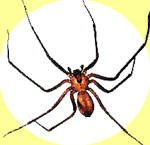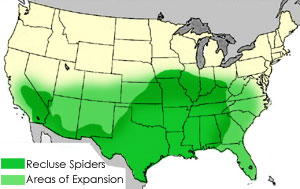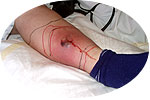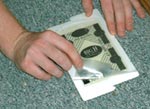
Brown Recluse spiders are known for their reclusive nature and avoid humans. However, despite their reclusive nature, they do bite humans. The most common situations resulting in bites are these:
- When people put on clothing or shoes (containing a spider) that were left on the floor overnight when the spider crawled into the object.
- When people blindly pick up or grab objects with out gloves in a secluded or rarely visited area.
- When people roll over in bed on a spider that had climbed up the covers that were touching the floor.
This site answers many common questions:
How do I recognize a Brown Recluse Spider?
Where do Brown Recluse Spiders live?
What happens if I get bit?
How do I control my Spider Problem?
Are those Email Photos of a Brown Recluse Spider Bite
real?
Where can I find other resources?
Find
a Local Dealer!
or
Buy
Online!
Have a question about spiders? Let SpiderExpert answer it!
Read Stories about Spider Bites and share your own.
How Do I recognize a Brown Recluse Spider?
 The
most recognized feature of the Brown Recluse spider is violin pattern
on the cephalothorax or in other words the location on the top side of
the spider near the head. Thus they have been nick named the Fiddleback
Spider.
The
most recognized feature of the Brown Recluse spider is violin pattern
on the cephalothorax or in other words the location on the top side of
the spider near the head. Thus they have been nick named the Fiddleback
Spider.
The violin pattern is common in adult brown recluses, but some young brown recluse spiders do not have any contrasting pigmentation in the violin region.
Recluse spiders also have abdomens devoid of any coloration pattern. Their legs lack thickened spines but are covered with fine hairs.
Unlike most U.S. spiders, the Brown Recluse spider has six eyes arranged
in pairs called dyads. (Most U.S. spiders have eight eyes arranged in
two rows of four.) One dyad is anterior, or toward the front and
the other two are lateral, or toward the sides of the cephalothorax (where
the first legs of the spider attach to the body). All 13 species
of U.S. recluses have this same eye pattern.
Return to top
Find
a Local Dealer!
or
Buy
Online!
Have a question about spiders? Let SpiderExpert answer it!
Read Stories about Spider Bites and share your own.
Where do Recluse Spiders live?
 Recluse
spiders are found in the south from California to Virginia. They've been
found as far north as Nebraska, Iowa, Illinois, Indiana, and Ohio.
Recluse
spiders are found in the south from California to Virginia. They've been
found as far north as Nebraska, Iowa, Illinois, Indiana, and Ohio.
This map shows areas that are known to have Recluse Spiders and areas into which they are moving. They may also be in other areas.
Find
a Local Dealer!
or
Buy
Online!
Have a question about spiders? Let SpiderExpert answer it!
Read Stories about Spider Bites and share your own.
What Happens if I get bit?
 About
50% of Hobo Spider bites are 'dry,' meaning that no venom is injected
and nothing happens to the victim. In fact, often times the victim
does not even realize that he has been bit. Typically, when venom
is injected, the victim will experience an immediate redness which develops
around the bite then begins to disappear within a few hours. Very
often, for the first 24 hours, the bite appears to be no worse than that
of a mosquito; then it begins to blister in the center. Within 24
to 36 hours the blister breaks open, leaving an open, oozing ulceration.
About
50% of Hobo Spider bites are 'dry,' meaning that no venom is injected
and nothing happens to the victim. In fact, often times the victim
does not even realize that he has been bit. Typically, when venom
is injected, the victim will experience an immediate redness which develops
around the bite then begins to disappear within a few hours. Very
often, for the first 24 hours, the bite appears to be no worse than that
of a mosquito; then it begins to blister in the center. Within 24
to 36 hours the blister breaks open, leaving an open, oozing ulceration.
This ulceration 'scabs' over within three weeks from the initial bite, leaving a permanent scar. If the bite is delivered in fatty tissue, the lesion may be very deep and extensive, not healing for over two or three years. Systematic reactions to Hobo Spider poisoning include severe headaches, nausea, vomiting, soreness and flu-like symptoms. In extreme cases where the bite was not taken care of early, skin graft, amputation, and the possibility of bone marrow failure may occur.
Many people have
received and email with photos of a Brown Recluse Spider bite. Click
here to read an expert's opinion about their authenticity.
Return to top
Find
a Local Dealer!
or
Buy
Online!
Have a question about spiders? Let SpiderExpert answer it!
Read Stories about Spider Bites and share your own.
Big H products also offers a large catalog of great products for Home
& Garden such as Fly
traps, Yellow
Jacket Traps, DiggitTM
tools, novelty
lighters, and more.
Click here to see our complete catalog of products.
 How
Do I Control my Brown Recluse Spider Problem?
How
Do I Control my Brown Recluse Spider Problem?
Brown Recluse Spider bites can make the victim very sick. They look like Hobo Spider bites, the two are often confused. If you are bit, seek medical attention! But don't wait to get bit; get rid of your Brown Recluse Spiders today the most effective way.
 If
you live in Brown recluse territory, our Big H TrapsTM
are recommended by spider experts for controlling Brown Recluse Spiders
instead of poisons and pesticides.
If
you live in Brown recluse territory, our Big H TrapsTM
are recommended by spider experts for controlling Brown Recluse Spiders
instead of poisons and pesticides.
Rather than exposing yourself and your family to poison (sprays
& pesticides), place non- poisonous and natural-attractant-baited
Big H TrapsTM to trap Brown Recluse Spiders when they
move into your homes to keep you feeling safe.
Buy Traps!
 To
use the traps most effectively for brown recluse spiders, place traps
in closets or other secluded areas where you have seen spiders and/or
webs. Brown Recluse spiders are known for their reclusive nature
and avoid humans. However, despite their reclusive nature, they
do bite humans. The most common situations resulting in bites are
these:
To
use the traps most effectively for brown recluse spiders, place traps
in closets or other secluded areas where you have seen spiders and/or
webs. Brown Recluse spiders are known for their reclusive nature
and avoid humans. However, despite their reclusive nature, they
do bite humans. The most common situations resulting in bites are
these:
- When people put on clothing or shoes (containing a spider) that were left on the floor overnight when the spider crawled into the object.
- When people blindly pick up or grab objects with out gloves in a secluded or rarely visited area.
- When people roll over in bed on a spider that had climbed up the covers that were touching the floor.
Big H products also offers a large catalog of great products for Home
& Garden such as Fly
traps, Yellow
Jacket Traps, Mouse Traps and more.
Click here to see our complete catalog of products.
Find
a Local Dealer!
or
Buy
Online!
Have a question about spiders? Let SpiderExpert answer it!
Read Stories about Spider Bites and share your own.
Email Photos of Spider Bites - Are they Real?
Many people have been circulating a series of images showing a terrible bite with the skin deteriorating to the bone claiming the injury to be a brown recluse spider bite. An expert offers the following:
Return to topIt is possible that the wound did result from a recluse bite. However, a number of aspects of this story are pretty suspicious, and have the classic symptoms of a hoax.
No one can seem to verify where the alleged bite occurred, whether a spider was caught in the act of biting or at the scene of the crime, whether the victim was tested for additional etiologic agents of necrosis such as bacterial infection, if a doctor actually made the diagnosis or it was a self-diagnosis from the victim, if the diagnosis came from an area of the country that actually has brown recluses, etc.
Some versions of this have included a picture of a spider that was supposed THE spider that caused the wound. Not so. It is a stock photo from an Ohio university website. This image was used last year in a very hyperbolic news story in Long Island.
The final summary on this is that if it indeed is a brown recluse bite, then it is truly one of the rare, horrific ones however, there is not sufficient information provided with this image to ascertain whether it is credible or not.
Rick Vetter Entomology Univ. Calif. Riverside Riverside, CA 92521
Find
a Local Dealer!
or
Buy
Online!
Have a question about spiders? Let SpiderExpert answer it!
Read Stories about Spider Bites and share your own.
Other Resources
Have your questions answered:
SpiderExpert.com
Read Stories about Spider Bites and share your own.
Read what Dr. Kenneth Burton has to say.
Learn more about HoboSpiders:
HoboSpider.com
©2003 Big H Products, Inc.
designed by PlanetAdvertise.com